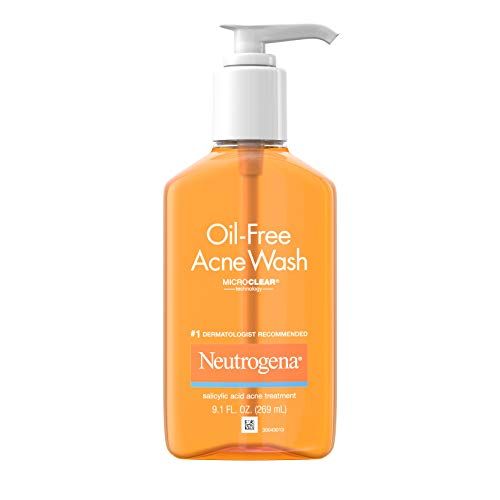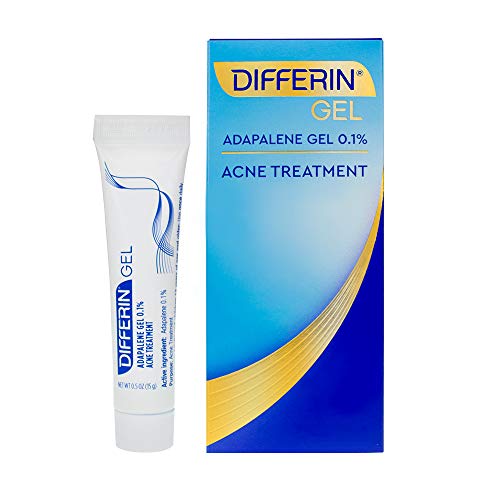
Suddenly dealing with acne breakouts after having your pimples under control for years? The cause may be adult-onset hormonal acne. Turns out, we don’t stop dealing with acne after our teen years: Common among women in their 20s and 30s, hormonal acne tends to appear along the lower third of your face and is caused by — you guessed it — fluctuating hormones. We tapped three board-certified dermatologists to help break down what hormonal acne is, what causes it and, of course, the best treatment options.
Meet the experts:
What is hormonal acne?
“Hormonal acne is acne that stems from hormonal shifts in adulthood, resulting in all kinds of blemishes – blackheads, whiteheads and painful cysts,” says Dr. Hartman. While all acne is caused by hormones to some extent — and people of all ages and genders can suffer from hormonal acne — typically the term “hormonal acne” refers to inflammatory adult acne that appears (or worsens) in adult women between the ages of 20 and 50. Adult acne is much more common than you may think. “In fact, 54% of adult women and 40% of adult men suffer from acne, and many of them do not have a history of acne as a teenager,” notes Dr. Hartman.
The two biggest tell-tale signs that you’re dealing with hormonal acne are that your breakouts worsen around menstruation and tend to appear across your jawline, chin and lower cheeks. However, not all hormonal acne will look the same. “While hormonal acne often appears as deeper red, cystic breakouts on the lower part of the face along the jawline, it can also be characterized by whiteheads and blackheads,” says Dr. Garshick. “It can also appear on the neck, chest, shoulders and as back acne.”
More From Good Housekeeping
What causes hormonal acne?
“Hormonal acne is acne that occurs when a person’s hormone level fluctuates,” says Dr. Garshick. Fluctuations of estrogen, progesterone and testosterone — mostly during menstruation cycles, pregnancy and menopause — will cause pimples to pop up.
These hormonal changes cause the body to overproduce pore-clogging sebum, which then “leads to inflammation, changes in skin cell activity and colonization of bacteria in hair follicles,” adds Dr. Garshick. “With this combination, acne starts to appear.”
The hormonal fluctuations that cause hormonal acne can be triggered by:
- Hormonal changes: Menstruation, pregnancy, menopause, PCOS
- Lifestyle: Stress, anxiety, diet, lack of sleep
- Medications: Starting or stopping birth control, certain supplements, testosterone therapy, steroids
Does adult hormonal acne go away?
While the breakout cycles themselves usually only last two to three weeks, you may be dealing with hormonal acne for years, especially during your 20s and 30s and then again going into menopause, Dr. Hartman warns. But, with the right treatment plan, it is possible to keep hormonal acne breakouts at bay.
The best ways to treat and prevent hormonal acne
There are several different treatment options that can help you get rid of hormonal acne, but you should start by talking to a dermatologist about how best to tackle your breakouts, especially if you’re experiencing cystic, inflammatory acne. Your derm can help come up with a plan that works specifically for your needs. Note that while over-the-counter acne products can be especially effective if you’re only dealing with mild breakouts, when it comes to cystic acne (which is what hormonal acne tends to be), it’s likely you’ll need to incorporate prescription-strength acne products and oral medications into your routine, in addition to certain lifestyle changes. But whatever course you take, note that consistency and patience is key.
Here are some additional potential solutions your dermatologist may discuss with you:
1. Start a consistent skincare routine.
According to Dr. Hartman, the best place to start dealing with and preventing hormonal acne is to wash your face one to two times daily with an acne face wash, refrain from harsh scrubbing and avoid picking or popping pimples. “Also, keep your hair clean and try to avoid touching your face unnecessarily,” he adds.
Any effective acne skincare routine starts with gently washing your face. You can use a cleanser that contains an acne-fighting ingredient, or opt for a gentle foaming cleanser followed by a separate topical treatment. Cleansers containing exfoliating ingredients such as salicylic acid or lactic acid will help to exfoliate skin and prevent clogged pores, and are best for those experiencing mild whiteheads or blackheads; face washes with benzoyl peroxide target surface bacteria and are best for red, inflammatory acne. When it comes to benzoyl peroxide cleansers, Dr. Zeichner recommends products with 10% concentration “because they sit on the skin for only a short period of time, [so] a higher concentration gives a better chance of penetration into the follicles before it is washed off of the skin.”
If you’re just experiencing mild breakouts, you may want to try incorporating an over-the-counter topical treatment containing benzoyl peroxide or salicylic acid into your skincare routine, since leave-on products can be even more effective than a face wash that rinses off in just a few minutes. (Just note that OTC products will likely not be effective enough on their own to get rid of hormonal acne; your dermatologist may recommend using OTC products in addition to prescription medication.)
“Benzoyl peroxide is perhaps the most effective ingredient we have for red, angry pimples,” says Dr. Zeichner. So, if this is what your hormonal acne looks like, keeping a benzoyl peroxide product in your rotation may be your best bet. Studies have shown that benzoyl peroxide is equally effective at 2.5, 5 and 10% concentrations, but it has the potential to be irritating, so Dr. Zeichner recommends starting off with a lower concentration. Just take into account that because hormonal acne is caused by hormonal shifts rather than bacteria, “benzoyl peroxide will not be as effective as it would be for patients who deal with bacterial acne,” says Dr. Hartman. That being said, most of the dermatologists we spoke with still recommend giving it a try.
Salicylic acid and glycolic acid products can potentially benefit hormonal acne patients, as well. “Salicylic acid can help reduce inflammation and pimple size and glycolic acid will exfoliate the skin’s surface, which helps keep pores clear,” Dr. Hartman says.”When it comes to salicylic acid, I recommend a higher concentration whenever possible, so long as you are not irritated,” adds Dr. Zeichner. You can also try incorporating a face mask containing salicylic acid or sulfur into your skincare routine alongside other topical treatments.
2. Try a prescription retinoid.
Retinoids are a key player in any skincare regimen, but especially one for acne. Retinol creams can “regulate exfoliation, decongest the pores and control oil which will all impact acne positively,” says Dr. Hartman.”Retinoid products are a great option to use in adults because they also have collagen-stimulating effects to also improve the appearance of aging skin,” adds Dr. Zeichner.
Because retinoids can often cause dryness or irritation at the early stages of use, both Dr. Hartman and Dr. Zeichner recommend the prescription medicine Altreno. It “contains prescription strength tretinoin in a hydrating lotion vehicle that is well tolerated by most patients,” says Dr. Hartman.
However, if you don’t want to use a prescription-strength retinoid, Dr. Garshick and Dr. Zeichner also recommend Differin Gel, which is a prescription-strength retinoid available over-the-counter. It contains 0.1% adapalene (a type of retinoid) and “works like a pipe cleaner to keep the pores clear,” says Dr. Zeichner.
3. Try a prescription oral medication.
If OTC treatments or prescription topicals aren’t doing the trick, ask your dermatologist about oral medications. Especially if you have deeper, painful cystic acne, topicals may need to be supplemented by oral medication. One option that Dr. Zeichner and Dr. Garshick recommend is spironolactone, an oral blood pressure medication that helps lower oil production and secretion. Spironolactone can take up to three months to show effects, but many hormonal acne sufferers swear by it. (There is also a new topical version of spironolactone called Winlevi.)
There are also several oral contraceptives that are also FDA-approved to treat hormonal acne and are sometimes prescribed in conjunction with spironolactone. They work by regulating your hormones and decreasing testosterone, which can reduce hormone-fueled breakouts. “Yaz, Beyaz, Ortho Tri-Cyclen and Estrostep are the four pills that are FDA-approved to treat acne, but most of the combination oral contraceptive pills are useful,” says Dr. Zeichner. (Combination pills are birth control pills that contain both estrogen and progestin.) You can talk to your dermatologist or gynecologist about getting a prescription.
4. See if a vitamin or supplement might help.
If you’re not comfortable trying a prescription medication, there are some vitamins and supplements that could potentially help treat hormonal acne. First up: Nicotinamide, a form of vitamin B3 that may help acne due to its anti-inflammatory effects. In studies, both topical and oral vitamin B3 supplements have been shown to improve acne, according to Dr. Garshick. It’s also possible that zinc can help hormonal acne. “Zinc supplements have been shown to reduce breakouts,” says Dr. Zeichner, though some studies show that treating acne topically with zinc might be the more effective route.
All that said, it’s important to always check with your doctor first before taking any new supplements, especially since taking too much of any supplement has the potential to be harmful. “It is also best to only start one new supplement at a time to be able to identify what is helping or if any side effects occur,” says Dr. Garshick.
5. Adjust your diet.
“The biggest contributing factors to adult acne are hormones, stress and diet,” says Dr. Zeichner. “Foods with a high glycemic index — which are foods that have a high sugar or starch load — raise blood sugar levels which promote inflammation and oil production,” he explains. In particular, cow’s milk (particularly skim milk), whey protein and vitamin B12 supplements have all been linked to acne flare-ups, Dr. Zeichner notes. Instead, “stick to whole grains rather than processed sugar, and consider a cow’s milk alternative, like almond or oat milk,” he advises.
6. Try to reduce your stress levels.
In addition to sticking to a hormonal acne-friendly diet and skincare routine, Dr. Zeichner recommends finding stress-reducing outlets, such as yoga or meditation. You should also make sure you’re getting the proper amount of sleep you need every night. Beyond that, if you’re looking for other ways to treat your acne naturally, ingredients like tea tree oil may help, though this may be a better choice if you’re only dealing with mild to moderate breakouts, rather than cystic breakouts.
Beauty Assistant
Catharine (she/her) is the beauty assistant at Good Housekeeping, Woman’s Day and Prevention, working closely with the Good Housekeeping Institute Beauty Lab to write science-backed beauty content. She was previously an assistant beauty editor at Group Nine Media and returned to Hearst in 2022 after having held editorial internships at Harper’s Bazaar and CR Fashion Book. Catharine received a B.A. in journalism from the University of Southern California’s Annenberg School for Communication and Journalism.
Xhicboutique.com – Search for this Product & More at Fun Prices!
Source link









